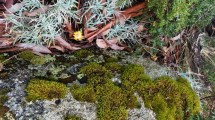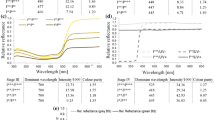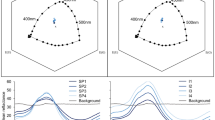Summary
-
1.
The spontaneous choice behavior of bees between two lights—a reference light of constant intensity (I c) and a test light of variable intensity (I v )—was tested by means of a binary choice apparatus.
-
2.
The intensity discrimination threshold for white light was determined in an intensity range of five powers of ten. Defining 65% choice frequency as reaction threshold, an intensity difference of 14.5% is perceived at the highest intensity tested (I c=3.6 W/m2=relative intensity 1). This difference increases only slightly, to 18.7%, with a decrease in relative intensity to 10−3, but at a relative intensity of 10−4 it increases to 57.2% (Fig. 3).
-
3.
According to these findings the least potential difference noted at receptor niveau is about 1 mV as can be determined by means of the intensity characteristic of the photoreceptors (Fig. 8).
-
4.
The intensity discrimination sensitivity in ultraviolet, blue, and green monochromatic light was determined. No significant differences were found (Fig. 4).
-
5.
An action spectrum, i.e., the spectral sensitivity function of the spontaneous phototactic choice behavior was determined by measuring the intensities of different monochromatic lights which are equally attractive as the constant reference light (I c). It has maxima in the ultraviolet (350–360 nm) and in the green range (530–540 nm; Fig. 5). The relative amplitude of the maxima depends on the intensity of the reference light: The green sensitivity decreases when the intensity of the reference light is increased (Fig. 7, insert).
Similar content being viewed by others
References
Autrum, H., Seibt, U.: Die Dunkeladaptation des Bienenauges. Naturwissenschaften52, 566 (1965)
Autrum, H., Zwehl, V. von: Die spektrale Empfindlichkeit einzelner Sehzellen des Bienenauges. Z. vergl. Physiol.48, 357–384 (1964)
Baumann, F.: Slow and spike potentials recorded from retinula cells of the honeybee drone in response to light. J. gen. Physiol.52, 855–875 (1968)
Bertholf, L. M.: Reactions of the honeybee to light. J. agric. Res.42, 379–419 (1931a)
Bertholf, L. M.: The distribution of stimulative efficiency in the ultraviolet spectrum for the honeybee. J. agric. Res.43, 703–713 (1931b)
Cruse, H.: Versuch einer quantitativen Beschreibung des Formensehens der Biene. Kybernetik11, 185–200 (1972)
Daumer, K.: Reizmetrische Untersuchungen des Farbensehens der Bienen. Z. vergl. Physiol. 38, 413–478 (1956)
Daumer, K.: Kontrastempfindlichkeit der Bienen für “Weiss” verschiedenen UV-Gehalts. Z. vergl. Physiol.46, 336–350 (1963)
Eheim, W. P., Wehner, R.: Die Sehfelder der zentralen Ommatidien in den Appositionsaugen vonApis mellifica undCataglyphis bicolor (Apidae, Formicidae; Hymenoptera). Kybernetik10, 168–179 (1972)
Fermi, G., Reichardt, W.: Optomotorische Reaktionen der FliegeMusca domestica. Kybernetik2, 15–28 (1963)
Gemperlein, R., Smola, U.: Übertragungseigenschaften der Sehzelle der SchmeissfliegeCalliphora erythrocephala, 3. Verbesserung des Signal-Störungs-Verhältnisses durch praesynaptische Summation in der Lamina ganglionaris. J. comp. Physiol.79, 393–409 (1972)
Goldsmith, T. H.: The nature of retinal action potential and the spectral sensitivities of ultraviolet and green receptor systems of the compound eye of the worker honeybee. J. gen. Physiol.43, 775–799 (1960)
Goldsmith, T. H.: The course of light and dark adaptation in the compound eye of the honeybee. Comp. Biochem. Physiol.10, 227–237 (1963)
Gribakin, F. G.: Cellular basis of color vision in the honeybee. Nature (Lond.)223, 639–641 (1969)
Gribakin, F. G.: The distribution of the long wave photoreceptors in the compound eye of the honeybee as revealed by selective osmic staining. Vision Res.12, 1225–1230 (1972)
Hecht, S.: A theoretical basis for intensity discrimination in vision. Proc. nat. Acad. Sci. (Wash.)20, 644–655 (1934)
Heintz, E.: La question de la sensibilité des abeilles à l'ultra-violet. Insectes soc.6, 223–229 (1959)
Helversen, O. von: Zur spektralen Unterschiedsempfindlichkeit der Honigbiene. J. comp. Physiol.80, 439–472 (1972)
Hörmann, M.: Über den Helligkeitssinn der Bienen. Z. vergl. Physiol.21, 188–219 (1934)
Labhart, T.: The discrimination of light intensities in the honeybee. In: Information processing in the visual systems of arthropods, p. 115–119 (R. Wehner, ed.). Berlin-Heidelberg-New York: Springer 1972
Labhart, T.: Verhaltensphysiologische Bestimmung der Intensitäts- und Spektralempfind-lichkeit der Honigbiene,Apis mellifera. Dissertation, Universität Zürich (1973)
Menzel, R.: Das Gedächtnis der Honigbiene für Spektralfarben, II. Umlernen und Mehrfachlernen. Z. vergl. Physiol.63, 290–309 (1969)
Neese, V.: Zur optischen Orientierung der Augenmutante “Chartreuse” vonApis mellifica. Z. vergl. Physiol.60, 41–62 (1968)
Portillo, J. del: Beziehungen zwischen den Öffnungswinkeln der Ommatidien, Krümmung und Gestalt der Insektenaugen und ihrer funktioneilen Aufgaben. Z. vergl. Physiol.23, 100–145 (1936)
Sachs, L.: Statistische Auswertungsmethoden, 2. Aufl. Berlin-Heidelberg-New York: Springer 1969
Sander, W.: Phototaktische Reaktionen der Bienen auf Lichter verschiedener Wellenlänge. Z. vergl. Physiol.20, 267–286 (1933)
Scholes, J.: The electrical responses of the retinal receptors and the lamina in the visual system of the flyMusca. Kybernetik6, 149–162 (1969)
Schümperli, R. A.: Evidence for color vision inDrosophila melanogaster through spontaneous phototactic choice behavior. J. comp. Physiol.86, 77–94 (1973)
Shaw, S. R.: Interreceptor coupling in ommatidia of drone honeybee and locust compound eyes. Vision Res.9, 999–1029 (1969)
Snedecor, G. W., Cochram, W. G.: Statistical methods, 6th ed. Ames, Iowa: Iowa State University Press 1967
Thomas, I., Autrum, H.: Die Empfindlichkeit der dunkel- und helladaptierten Biene für spektrale Farben: Zum Purkinje-Phänomen der Insekten. Z. vergl. Physiol.51, 204–218 (1965)
Varela, F. G.: Fine structure of the visual system of the honeybee (Apis mellifica), II: The lamina. J. Ultrastruct. Res.31, 178–194 (1970)
Wehner, R.: Pattern recognition in insects. In: Compound eye and vision in insects (G. A. Horridge, ed.). Oxford: Clarendon Press (in press)
Wehner, B., Toggweiler, F.: Verhaltensphysiologischer Nachweis des Farbensehens beiCataglyphis bicolor (Formicidae, Hymenoptera). J. comp. Physiol.77, 239–255 (1972)
Wolf, E.: The visual intensity discrimination of the honeybee. J. gen. Physiol.16, 407–422 (1933)
Zettler, F., Järvilehto, M.: Lateral inhibition in an insect eye. Z. vergl. Physiol.76, 233–244 (1972)
Author information
Authors and Affiliations
Additional information
Shortened text of thesis performed under the leadership of Prof. Dr. R. Wehner, presented to the Philosophische Fakultät II of the University of Zürich. I thank Drs. C. A. G. Wiersma and T. H. Goldsmith for reading the manuscript.
Financially supported by grant no. 3.315.70 of the Fonds National Suisse de la Recherche Scientifique awarded to Prof. Dr. R. Wehner.
Rights and permissions
About this article
Cite this article
Labhart, T. Behavioral analysis of light intensity discrimination and spectral sensitivity in the honey bee,Apis mellifera . J. Comp. Physiol. 95, 203–216 (1974). https://doi.org/10.1007/BF00625444
Received:
Issue Date:
DOI: https://doi.org/10.1007/BF00625444




